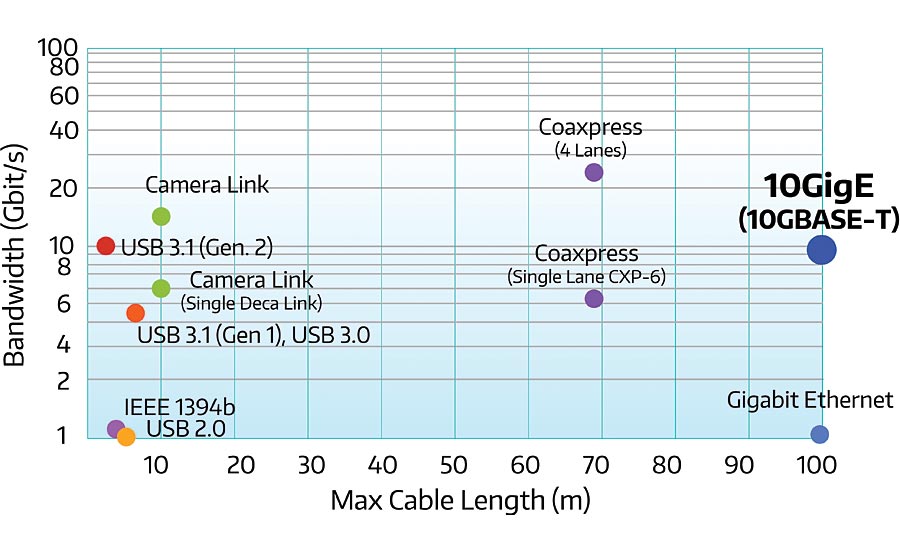Ethernet Evolution – 10 Gigabit Ethernet
With 10 gigabit ethernet, higher bandwidth is added to the familiarity and reliability of gige vision cameras and twisted pair cabling

Figure 1. Bandwidth vs. cable length. 10 GigE provides both high bandwidth and a long maximum cable length without repeaters or optical extensions.

Figure 2. 10 GigE Install base growth. 10GBASE-T over Cat6A has the fastest growing install base of all the 10 GigE technologies.

The 10 Gigabit Ethernet interface builds on proven GigE Vision technology to keep bandwidth and CPU usage low.



The new standard in single-link interface speed, 10 Gigabit Ethernet (10 GigE), enables users to take full advantage of the latest generation of high-performance sensors with their higher resolution, frame rates, bit depth and dynamic range.
10 GigE cameras are also fast to set up. With the latest generation of consumer motherboards supporting 10 GigE, all you need is a camera and a cable. There’s no complicated link aggregation to set up, and unlike Camera Link or CoaXpress, there’s no need for frame grabbers or additional interface cards.
The 10 Gigabit Ethernet interface builds on proven GigE Vision technology to keep bandwidth and CPU usage low. In our tests, a free-running 10 GigE camera consumed only about 15% of the maximum load of an Intel i7-6700 CPU.
Reliable
Image data is only useful once it arrives in host memory. 10 Gigabit Ethernet offers packet resend to prevent data loss by detecting and correcting errors in real-time. By contrast, Camera Link requires expensive cables to manage bit errors.
Lower Cost
In addition to being faster and easier than single lane Camera Link and CXP-6 CoaXpress interfaces, 10 Gigabit Ethernet over CAT6A is much less expensive. By maintaining GigE Vision compatibility, 10 GigE cameras eliminate the need for expensive frame grabbers.
Camera Link, CoaXpress, and optical fiber installations require expensive premade cables. Using CAT6A cables with the familiar RJ45 connector allows for quick and easy field termination. With 10 GigE, you always get the perfect length of cable, so you only pay for the length you need. Inexpensive cabling reduces the lifecycle cost of CAT6A installations by lowering maintenance expenses compared to Camera Link, CoaXpress and SFP+/Fiber.
Low Latency
The superior speed of 10 Gigabit Ethernet delivers a significant reduction in latency compared to gigabit hardware, which includes IP forwarding steps that introduce 50-125 µs of latency. 10 Gigabit Ethernet reduces latency to just 5-50 µs, making it ideal for lag-free, real-time video applications such as motion-tracking, conferencing, and telemedicine.
Efficient
10 Gigabit Ethernet leverages continual advancement in semiconductor manufacturing. Substantial and ongoing improvements in Physical Layer (PHY) power efficiency have been achieved as processes continue to shrink from greater than 60nm to 28nm, and ultimately to 14nm and lower.
10 Gigabit Ethernet auto-negotiation protocols can also scale power dynamically, based on cable length. With cables less than 7m long, the signal-to-noise ratio is high enough to disable some of the PHY’s signal processing features. This reduces power dissipation to as little as 1.5W per port—that’s just 1W more than SFP+ with the same length optical cable.
Widely Adopted
10GBASE-T has been widely adopted in the IT industry, and has proven every bit as reliable as the 1000BASE-T systems that came before. As this standard enters the consumer space, the install base is set to expand even faster. The 10GBASE-T platform used by 10 Gigabit Ethernet is a fully IEEE-compliant technology standard, ensuring interoperability between switches, motherboards, interface cards, cables, and cameras. This interoperability, combined with familiarity, ease of use, and low cost, has nurtured a healthy and growing ecosystem of standard-compliant 10GBASE-T products.
Using technology developed to enable 10 Gigabit Ethernet, the NBASE-T alliance is now working with the IEEE to develop and standardize 2.5 and 5 Gigabit Ethernet over CAT5e cables. 10 GigE cameras will be fully compatible with these emerging technologies, offering even greater flexibility and potential cost savings.
Easy Setup
The latest generation of high-resolution sensors is pushing interface bandwidths to their limits. In response, some camera manufacturers have turned to complicated link aggregation systems, latency compression, and short, buffered bursts. The superior bandwidth of 10 Gigabit Ethernet eliminates the need for these workarounds, delivering high resolution, high dynamic range images at high frame rates and extremely low latency, all over a single cable.
GigE Vision compliant
10 Gigabit Ethernet is fully compatible with GigE Vision hardware and software.
10 Gigabit Ethernet’s GenICam support gives out of box compatibility with third-party libraries. The GenICam standard accelerates vision application development by providing users with intuitive feature naming and guaranteed interoperability with other GenICam compliant products.
Cable Length up to 100m
CAT6A cabling allows for 10 GigE speeds at cable lengths up to 100m without repeaters, hubs or optical fiber extensions. By contrast, CXP-6 CoaXpress is limited to 68m, while Camera Link is limited to just 10m. CAT6A cables are also easily field terminated using shielded 10Gig connectors, simplifying large scale installations.
Backward Compatibility
10 Gigabit Ethernet devices on Gigabit Ethernet hardware will automatically step down to gigabit speed. This backward compatibility enables a simple upgrade path. The introduction of 2.5 and 5 Gigabit Ethernet over CAT5e will provide even greater flexibility in the upgrade path to 10 GigE.
Looking for a reprint of this article?
From high-res PDFs to custom plaques, order your copy today!






